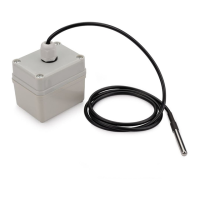
Do you have a question about the Dragino LSN50 and is the answer not in the manual?
| Brand | Dragino |
|---|---|
| Model | LSN50 |
| Category | Accessories |
| Language | English |
An overview of the LSN50 as a long-range LoRaWAN sensor node for outdoor data logging.
Details the microcontroller, DC characteristics, LoRa specs, battery, and power consumption of the LSN50.
Lists LoRaWAN compliance, MCU, wireless chip, IDE, interfaces, I/Os, and enclosure features of the LSN50.
Outlines typical applications for the LSN50, including smart buildings, logistics, and smart cities.
Identifies and describes the function of each pin on the LSN50 board for hardware interaction.
Records hardware modifications and feature additions across different LSN50 versions.
Details available hole size options for sensor cable entry with dimensional specifications.
Explains the default OTAA Class A mode, network joining process, and device operation flow.
Provides a step-by-step guide to connect the LSN50 to The Things Network (TTN) via OTAA.
Describes different working modes and their corresponding uplink payload structures for sensor data transmission.
Explains payload interpretation for battery, sensors (DS18B20, SHT20), and digital inputs.
Details downlink control types, FPort, type codes, and payload examples for device configuration.
Guides users on integrating LSN50 data with MyDevices for visualization and monitoring.
Lists firmware versions and the features or bug fixes introduced in each update.
Analyzes battery type, power consumption, and provides insights into battery life estimation.
Explains how to connect and access the LSN50 using AT commands via a USB to TTL adapter.
Provides common AT command sequences for ABP mode setup with different gateways.
Details the hardware connection and steps for upgrading firmware using a USB to TTL adapter.
Explains the hardware connection and steps for upgrading firmware using an ST-Link V2 programmer.
Provides download links for the software and hardware source code for development.
Guides on setting up the Keil compile environment and compiling the source code.
Explains the different hardware versions based on regional ISM band rules for LoRa.
Lists working frequencies and recommended bands for different LT LoRa versions.
Instructs users to follow image upgrade steps to select the correct region image.
Discusses using private LoRa protocols and provides a reference demo for basic LoRa transfer.
Explains how to configure the device for 8-channel mode using AT+CHE for better gateway compatibility.
Guides on setting up LSN50 for ABP mode with single-channel gateways like LG01/LG02.
Details how to configure EUI keys using AT commands, recommending the latest firmware version.
Addresses connection issues during firmware upload via UART, offering checklists and solutions.
Explains that TTN join issues in specific bands are due to channel mapping.
Provides guidance on troubleshooting AT command input issues, suggesting checking for ENTER key presses.
